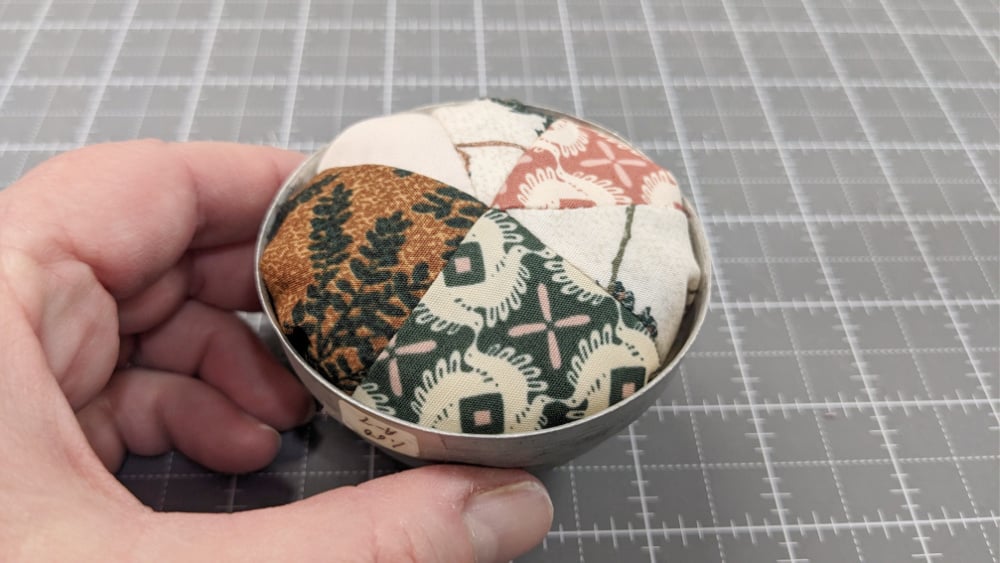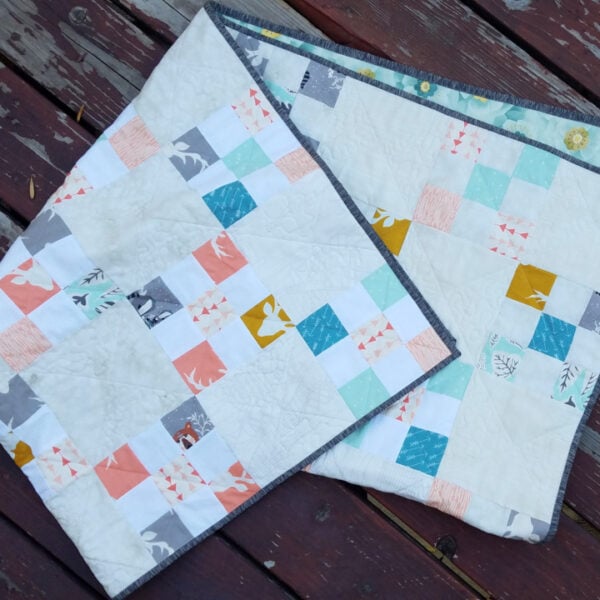Quilt as you go is a great technique for any sewer to know. The whole premise is- when you are done with the top, you are done with the bottom and quilting!
I love that you can quickly sew something together with this method. I keep to small sewing projects at the beginning. Easier to handle on the sewing machine and you are more likely to actually finish it!

Besides the simplicity of the steps, it is great for using up those little bits and scraps of fabric that you have hanging around. I never know what to do with them. Here is your chance to put them to work.
Materials needed for this technique:
* fabric scraps
* fabric for your back

Quilt as you go Tutorial:
1) Cut your fusible fleece a little larger than the finished size you need. The project I was working on used a 8″ X 10″ size. {You will trim down later}
* the reason I use fusible fleece- it holds the backing fabric while you are working on the top. If you don’t have it you can substitute it for regular batting and use pins or a spray adhesive.
2) Cut your back the same size as the fleece. Using the instructions provided, fuse the fleece to the wrong side of the backing fabric
3) Place a scrap -right sides facing up on the fleece side
4) Place another scrap -right sides facing the first scrap. Match one length of edge and pin in place
5) Sew along the matching edge, trim any extra fabric underneath if needed
6) Flip open and iron
7) Place another scrap- right sides facing. Match one legth of edge and pin in place
8) Continue steps 5-7 until you have covered the fleece
9) Iron well
10) If you’d like you can go back and sew some additional lines – just for finishing look sake
11) Trim the edges to the size you had decided on in step 1
Have you tried this technique yet? What tips and hints do you have?

Becky Jorgensen is the creative quilter behind Patchwork Posse, the Patchwork Planner and her online quilt group Patchworkers Plus. You can find her patterns in books, magazines, and her quilt membership. Gather your quilting supplies, organize your sewing space, explore the process of disappearing quilt blocks, or finish a free quilt pattern. I'll help you use what you have, finish what you start and make your quilting journey fun!
Follow me here: Facebook, Pinterest, YouTube







Hi, Becky. Yes i use this technique alot. I am an avid recycler so for me i use the center section of bedskirts that people nolonger want on their beds. I spend my time during spring/summer hitting yard sales, friends and people i meet save them even. I may hit a 2nd hand store also. Right now is a great time for me to get xmas material from those 2nd hand clothiers. I use a 12.5 square and piece my block, then put into a bin till I have enough for quilt top. Then I quilt with a sheet as batting and add flannel for backing then I use a 1″ strip as sashing and add next block till I am done with one row. Then i just add those rows together using a 1″ strip of sashing the length. I like it this way for me it is easier on my hands…….
Hi Becky! I have not tried this techinque before and think it would be much easier than quilting at the end. My question is how do you put all of the blocks together?
Tha ks,
Rebecca
Rebecca- great question! There a few tutorials out there on the finishing steps when the blocks are bigger. You basically sew them together like normal quilt blocks- right sides together. Then on the back you will have all the raw edges showing. You cover them with strips of fabric- similar to a binding strip. They cover the seams and look like a sashing. Does that make sense? I might have to do a round up for that! thanks for the idea.
That does make sense! Thank you!
I do this using regular Soft and Natural batting, which I cut to my finished size and a bit smaller than my backing (and finished front). Then, when I sew the top right sides together I’m not sewing the batting bulk into the seam – if I get it lined up right, the batting buts together smoothly. I iron the backing back on itself leaving a 1/4″ flap (do this before sewing the front – trust me!) and overlap them, stitching in the ditch from the front to secure. You could also sash the back, but so far this has worked for me for the smaller projects I tend to use QAYG for. A rag finish could be good for a baby quilt. I have also been known to skip the backing altogether when applying to top, for pillow covers for example. With mug rugs I put the backing on when I apply the binding. I just have to clean out my machine more often because of the lint.
what a great idea Lauren and yes, lint is a monster in the machine after all that!
I use this technique a lot. My most recent finished quilt is on my Pinterest site http://www.pinterest.com/faeb/ under My Projects. I have a great way to join the blocks that looks neat also. Maybe I should make a tutorial someday.
Faye- thanks for stopping by. I find that joining the backs is tricky. I keep to the smaller projects where you don’t have to do it. 🙂
Is there any way we can print this tutorial without all the other stuff?
After you have the blocks all done (the method with fusible fleece) , what method do you use to sew them together to hide the edges/ seams? Thanks for the ideas.
Sew them all together with the raw seams on one side. Then you’ll be using kind of like a hem tape to hide those. When you are done, those will look like sashing.
I really love your free patterns. Thank you for your tutorials,
Thanks
Thank you